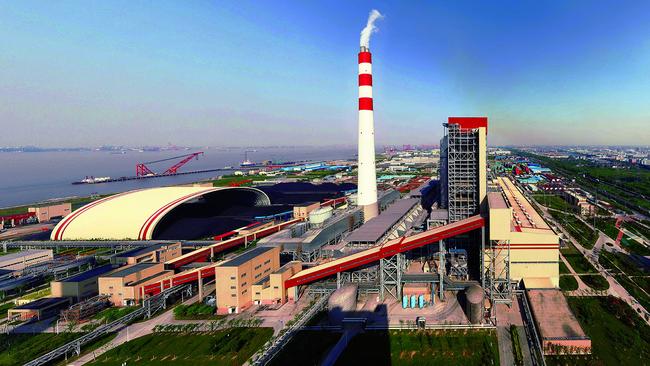HELE means coal power efficiency
If everyone matched China’s coal power efficiency, we’d reduce CO2 output by the equivalent of India’s emissions every year.

The average efficiency of coal-fired power plants around the world is about 33 per cent. But China, with half of the world’s coal power, has an average efficiency close to 40 per cent. This reflects China’s strong commitment to addressing environmental issues.
If the rest of the world’s coal fleet efficiency averaged 40 per cent as well, we’d reduce CO2 emissions by 2 gigatonnes each year. This is the equivalent of India’s current emissions.
Modern technology exists to do this. And we can do even better, as plants with efficiencies of up to 47 per cent operate around the world with further improvements anticipated.
Modern, high-efficiency, low-emission (HELE) technology enables coal generators to operate more efficiently. These plants also have emissions control technology that can reduce non-CO2 emissions to levels comparable with natural gas power plants.
Very deep cuts in CO2 emissions can then be achieved through the use of proven CO2 capture technologies and biomass co-combustion.
HELE plants operate at higher temperatures and pressures, more efficiently converting the energy in coal into electricity. This saves on fuel and reduces CO2 emissions. They also support increased levels of intermittent, renewable electricity generation, such as wind and solar PV.
That is because HELE plants provide the critical power security services that keep the lights on when there is a major upset or ‘event’ on the grid, something intermittent technologies cannot do.
These plants can also be designed to ramp up and down rapidly in response to changes in electricity demand. This bolsters the security of the network.
Moreover, HELE plants operate round the clock to meet electricity demand, during periods when the wind isn’t blowing or the sun isn’t shining.
They do this by using conventional ‘spinning’ (or synchronous) generators to produce electricity. This keeps the lights on after a major disruption, such as the loss of a power transmission interconnector between two states.
Synchronous generators act like a shock absorber, by rapidly providing stability when disturbances arising from abnormal events occur on the grid.
Non-synchronous generators use power electronics called inverters to connect to the grid. The physics of these non-synchronous devices means they are unable to provide the very rapid inherent grid services called ‘synchronous inertial response’ which is critical to keeping the lights on during the first second or two after a major grid disturbance.
HELE technology is already cost-competitive with other low-emissions technologies, as coal and gas technologies are the lowest cost per unit of electricity to build and operate.
But more can be done.
In its technology roadmap the US Electric Power Research Institute specifies R&D pathways to reduce CO2 intensity by improving the efficiency of existing coal- and gas-fired power plants.
Innovations are being pursued in the following areas:
•Sensing, monitoring, heat transfer, and process control for heat rate improvement
•Fuel switching and co-firing
•Advanced coal and gas power cycles, systems, components and plants
•Thermal and other non-battery energy storage technologies
•Carbon capture, storage, and utilisation processes.
Coal, in particular, is being targeted because, as the International Energy Agency says, it is an important and still growing source of energy for the world. So we must find ways to reduce its environmental footprint.
But the IEA is concerned that only about half of new coal-fired power units being constructed use HELE technologies. The Paris Agreement affords an opportunity for countries to work together to address that and advance these technologies even further.
In Japan and China, important advances have been made to improve existing materials used in high pressure/temperature HELE power plants. Improved fabrication and repair of advanced, high-temperature tolerant and stronger materials is ongoing.
The Waigaoqiao No. 3 HELE plant in Shanghai, for example, increased its efficiency from 43 per cent to more than 47 per cent. This is seen as “a tremendous achievement” by the IEA’s Clean Coal Centre (IEA CCC) in London.
Meanwhile, testing is under way on new materials designed to boost coal power efficiency beyond 50 per cent in technology centres in the US, China, Japan and Europe.
In addition, under its Paris Agreement undertakings, India has committed significant funding to advanced HELE technology.
The IEA CCC is about to release a report on state-of-the-art HELE technologies, such as:
•Integrated gasification combined cycle, which leads the way with several full-scale demonstration plants under construction
•Advanced ultra supercritical combustion
•Polygeneration, oxyfuel combustion, supercritical CO2 systems and hybrid systems.
The report identifies the technology gaps that need to be addressed for successful deployment along with an outline of the specific research, testing or demonstration which is required to address each gap.
The IEA CCC also produces regular reports on HELE developments and uptake around the world. A particular focus is on Asia where 60 per cent of the world’s population resides.
Asia is also the main area for coal consumption growth. For example, in Southeast Asia the IEA projects the share of coal in power generation will rise from 32 per cent to 50 per cent.
While Bangladesh and Malaysia are focused on state-of-the-art HELE technologies, India, Indonesia and Thailand are specifying less efficient, older technology for recent and planned plants.
Where countries don’t use the best available HELE technology for new capacity, significant tranches of the less efficient technologies will be installed to meet power demand and thus ‘locked in’ to the coal fleet for decades.
Given the importance of using HELE technologies to minimise emissions from coal use, their uptake is to be encouraged and assisted wherever possible.
Martin Oettinger is Deputy Director, Low Emissions Technologies, COAL21.

To join the conversation, please log in. Don't have an account? Register
Join the conversation, you are commenting as Logout